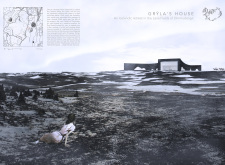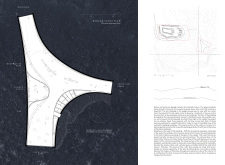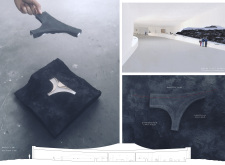5 key facts about this project
Grýla's House is located in the Lava Fields of Dimmuborgir, Iceland. This area has been shaped by volcanic activity and is rich in cultural stories. The building serves as a visitor center, allowing guests to connect with the natural landscape while reflecting the local mythology surrounding trolls and other beings. The design captures the essence of time in this region, where the sun and moon dictate the rhythms of daily life.
Form and Landscape Interaction
The structure consists of three curved walls that interact with nearby features such as Mývatn Lake, Hverfjall volcano, and the Dimmuborgir lava field. This form is not just for show; it deliberately engages with the environment, offering views that change throughout the day and across the seasons. The design aims to blend into the landscape, making it feel like a part of the earth rather than an external addition.
Entrance and Spatial Experience
Entering Grýla's House involves a descent into the ground, which enhances the visitor’s experience of nature. This downward movement creates a strong connection between the space inside and the wild surroundings. As people explore the building, they find a layout that flows smoothly from one area to another, allowing for both private moments and shared interactions.
Materiality and Interior Design
The exterior walls are finished with dark projected concrete, which helps the building blend with the deep hues of the landscape. This choice makes the structure appear as if it has always been part of the site. Inside, the walls feature poplar wood paneling, adding a soft warmth to the atmosphere. The simplicity of these materials creates a feeling of authenticity, encouraging people to engage with the environment.
Design Details and Engagement
Cavern-like windows are a defining feature, framing views of the beautiful landscape while keeping the interior secure. These openings invite natural light, creating a calming environment that reflects the tranquility of the area. The careful placement of windows allows light and shadow to interact in ways that enhance the experience within the building, reinforcing the connection to the outside world.






















































